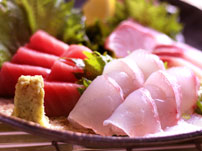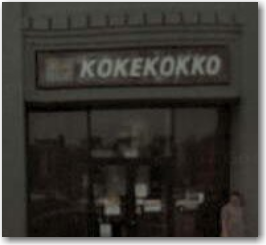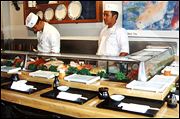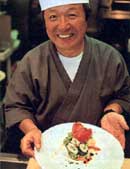 If neurotheology’s basic premise holds water, then a healthy brain is essential to a healthy spirit. And what better food to feed the brain than sushi, that quintessential Japanese classic, marrying the fruits of the sea and the rice paddy? Besides, it tastes good.
If neurotheology’s basic premise holds water, then a healthy brain is essential to a healthy spirit. And what better food to feed the brain than sushi, that quintessential Japanese classic, marrying the fruits of the sea and the rice paddy? Besides, it tastes good.
It helps that West Hollywood, our home, may have the highest concentration of sushi restaurants anywhere in the world—many within walking distance for us.
The sushi-ya closest to us, a mere three-minute walk, right across from the towering Pacific Design Center, is Nishimura, which I reported on here five years ago. This is the best sushi restaurant on the West Coast, or possibly in the US. Unfortunately, I can’t give you any recommendations for what’s best here, since Nishimura-san will decide that for you on any given day, piecing together ultra-creative, mouth-watering dishes from the supremely fresh neta he flies in from Japan. The problem is that a once-a-week meal here would consume a huge portion of my disposable income.
Down La Cienega we find Yabu (website), where it’s hard to go wrong with their competent sushi, good jizake collection, reasonable ambience, and dishes such as the Osaka-style pressed sushi which we love. Yabu also boasts a good soba menu, if you’re in that kind of mood.
As of late November, 2005, our all-time favorite, Murakami, right down at the end of our street on Santa Monica, where we had spent many an enjoyable evening bantering with the master and wolfing down his imaginative concoctions, has been sold to a new chef/owner. A recent visit demonstrated that all is not well at our favorite Japanese sushi shop. The old Murakami ambience is completely gone. The entire wait staff is new, and very shaky. The service has now slowed down by a factor of two. It may be my imagination, but the fish itself—possibly the single aspect the chef/owner is most responsible for, on his daily buying trips—is of lower quality. The lovely flower arrangements the previous owner’s wife did are gone—replaced by a cold, barren wall. Murakami-san took with him not only the spirit of the restaurant, but also its name; it now goes by the undistinguished moniker “Ari-ya”.
A bit west on Santa Monica we find Ajisai, just up Palm, where chef Shoei presides over his tiny fresh fish empire, with friendly service, superb catches of the day, background jazz, and good conversation. Our favorite is the boiled squid stuffed with crab.
Down Beverly is Hirozen, also reviewed in this space last year. Although you can eat à la carte , you cannot go wrong with Hiro’s omakase chef’s selection. Highly recommended.
North of Santa Monica on La Cienega we find Wa Sushi & Bistro, the subject of considerable oohing and aahing in the local press when it opened last year, possibly because its chefs are graduates of the legendary Matushisa just a few blocks away. But we found the food overwrought, the service spotty. The albacore salad we had was drenched in an overly assertive miso sauce. They can’t just serve sea bass—it has to have foie gras on top. They can’t just serve soft-shelled crab—it has to have caviar on top. Price performance is poor. We won’t be visiting this place again soon.
The king of 90069 sushi places, of course, is the iconic Sushi Roku , down on 3rd just off La Cienega. It’s also a celebrity hangout; once I saw David Spade there, a fine actor, although I didn’t get the chance to tell him how much I liked him in Joe Dirt. Sushi Roku has long outlived its never justified reputation. Service is perfunctory. The only thing high-end about it is its prices.
Koi (website ) also made a big splash when it opened last year right near us on La Cienega across from L’Orangerie. This is definitely the place to go if you want to try “hamachi fusion soy citrus truffle essence” or “yellowtail carpaccio grapeseed oil and ponzu wasabi tobiko”, consumed in a space that boasts of being a “stylish, harmonious blend of of custom furniture, earth tones and soft light”. Of course, it’s not really a sushi place, instead its cuisine is “Japanese-inspired with California accents”. Its cavernous interior seats over 200 aspiring movie moguls and 20-something would-be models.
Given all the sushi joints in LA, one wonders why anyone with no sushi-making skills and not even from Japan would even bother trying the genre, but still there are those that do. One we recently had the misfortune of trying was Niko Niko Sushi, right next to Barney’s Beanery, famous as Janis Joplin’s favorite hangout when she lived down the street. Suffice it to say you’d be better off crossing the street to IHOP and getting their $2.99 pancake special.
Of course there are lots of sushi places up on Sunset which I make a point of never patronizing. They can’t decide whether they want to be overpriced tourist traps or starlet-encrusted sushi discos. However, Katana is worth a mention, and a visit. Although definitely awash in Hollywood glitter, and owned by the Sushi Roku crowd, it serves a reasonable menu of kushi—things on sticks, one of mankind’s most basic food formats. I like the stuffed mushrooms and rib-eye, and the lamb is worth a try. I wouldn’t recommend their sushi, though.
The granddaddy of upscale nouvelle cuisine Japonaise à la mer is, of course, Matsuhisa itself, on restaurant row on La Cienega. I’ll regale you with Matushisa stories in another post.
 Kokekokko is the best yakitori place in Los Angeles, and I’ve been to most. Here it’s all about the food. The first thing out were quail eggs, plump, slightly larger than usual, lightly charred. The “meatballs” (tsukune) were juicy and grilled to perfection. The moist tebasaki (wing) meat fell off the bones. “Toku-hatsu”, a fattier variety of hatsu (chicken heart), was a real revelation.
Kokekokko is the best yakitori place in Los Angeles, and I’ve been to most. Here it’s all about the food. The first thing out were quail eggs, plump, slightly larger than usual, lightly charred. The “meatballs” (tsukune) were juicy and grilled to perfection. The moist tebasaki (wing) meat fell off the bones. “Toku-hatsu”, a fattier variety of hatsu (chicken heart), was a real revelation.

 If neurotheology’s basic premise holds water, then a healthy brain is essential to a healthy spirit. And what better food to feed the brain than sushi, that quintessential Japanese classic, marrying the fruits of the sea and the rice paddy? Besides, it tastes good.
If neurotheology’s basic premise holds water, then a healthy brain is essential to a healthy spirit. And what better food to feed the brain than sushi, that quintessential Japanese classic, marrying the fruits of the sea and the rice paddy? Besides, it tastes good.